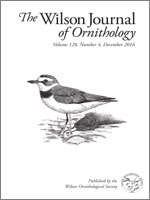We analyzed data from a woodland site for a 59-year period to determine whether changes in bird populations are related to changes in the diversity and relative abundance of woody plant species even when vegetation structure, degree of forest fragmentation in the surrounding landscape, and regional changes in bird populations are taken into account. Principal component analyses generated vegetation factors encompassing variables such as total basal area, shrub density, basal area of common tree species, and measures of tree and shrub species diversity. We also calculated a forest edge/forest area index based on GIS analysis of the landscape within 2 km of the study site. Poisson regression models revealed relationships between these covariates and population changes for 19 bird species and for seven groups of species characterized by similar migration strategies or habitat requirements. All groups of habitat specialists showed a positive relationship with the first vegetation factor, which indicates that they declined as total basal area and dominance of oaks and maples increased and as tree and shrub diversity decreased. This suggests that floristic diversity may be important for determining habitat quality. Bird species associated with the shrub layer and with hemlock stands showed positive relationships with the second vegetation factor, suggesting that the recent decline in eastern hemlocks (Tsuga canadensis) because of hemlock woolly adelgid (Adelges tsugae) had an adverse impact on these species. Forest migrants, shrub-layer specialists, long-distance migrants and permanent residents showed negative relationships with the forest edge/forest interior index, indicating that conservation efforts to protect bird communities should take the wider landscape into account. The strongest relationship for most species and species groups was with the first vegetation factor, which suggests that species composition and diversity of trees and shrubs may be especially important in determining abundance of many forest bird species.
How to translate text using browser tools
1 December 2016
Response of Bird Populations To Long-Term Changes In Local Vegetation and Regional Forest Cover
Mary L. Buchanan,
Robert A. Askins,
Chad C. Jones
ACCESS THE FULL ARTICLE
bird population declines
forest birds
forest fragmentation
hemlock decline
tree species composition





